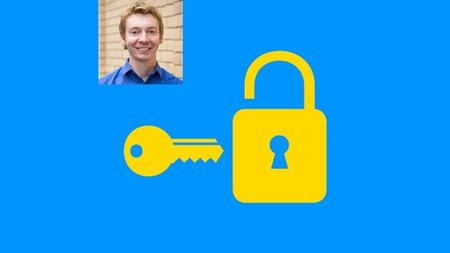English | MP4 | AVC 1280×720 | AAC 44KHz 2ch | 45 lectures (8h 19m) | 4.37 GB
From Caesar to Enigma, and beyond
Cryptography is the science of secrets and secret messages. In this course we will learn more about the mathematics behind codes and code breaking.
The course will start with easy ciphers and how they were broken, before moving to more sophisticated ciphers including the famous World War II Enigma machine and modern internet encryption.
The course contains over 6 hours of lectures, with an additional 2 hours of exercises and solution videos.
Topics covered in the course include:
- Monoalphabetic ciphers;
- Modular arithmetic;
- Polyalphabetic ciphers;
- The Enigma Machine; and
- Public Key Cryptography.
During this course we will introduce many important mathematical concepts including modular arithmetic, sets, functions, probability, statistics, combinatorics and number theory.
Ciphers and techniques in the course include:
- Substitution ciphers;
- Transposition ciphers;
- Commuting ciphers;
- Frequency analysis;
- The Vigenere cipher;
- The Kasiski test;
- Index of Coincidence;
- The Friedman test;
- Diffie-Hellman;
- Elliptic curve cryptography;
- RSA internet encryption; and
- Digital signatures.
Finally, we will end the course with a brief look at the future of cryptography.
The course is intended to be self-contained and comes with a set of notes that you can complete as we go through the course.
The course comes with many exercises after each section, with solutions, that allow you to test what you have learnt.
Cryptography touches on a broad range of topics and is one of the most fascinating applications of maths. By the end of this short course, we will have introduced several fundamental ideas in mathematics, and even answer whether there such a thing as an unbreakable code.
What you’ll learn
- Understand the methods of classical cryptography such as monoalphabetic ciphers, polyalphabetic ciphers and transposition ciphers.
- Understand the mathematics of modular arithmetic.
- Understand and apply the methods of classical cryptanalysis such as the Kasiski Test and Friedman Test.
- Understand the Enigma Machine and the method used to break Enigma in World War II.
- Understand the mathematics of RSA internet encryption.
Table of Contents
Welcome and Resources
1 Welcome
Introduction
2 Introduction
Monoalphabetic Ciphers
3 The Caesar Shift and Monoalphabetic Ciphers
4 Modular Arithmetic part 1
5 Solutions Modular Arithmetic 1
6 Modular Arithmetic part 2
7 Solutions Modular Arithmetic 2
8 Additive Ciphers
9 Solutions Additive Ciphers
10 Common Divisors part 1
11 Common Divisors part 2
12 Solutions Common divisors and Euclid’s algorithm
13 Multiplicative and Affine Ciphers
14 Solutions Multiplicative and Affine ciphers
15 General Substitution Cipher
16 Solutions General substitution ciphers
17 Frequency Analysis
18 Solutions Frequency analysis.
19 Transposition Ciphers
20 Commuting Ciphers
Polyalphabetic Ciphers
21 Vigenere Cipher
22 Solutions Vigenere ciphers
23 Breaking Vigenere
24 Probability
25 Index of Coincidence
26 The Friedman Test
27 Solutions Breaking Vigenere
28 One Time Pad
Enigma
29 Enigma
30 Combinations
31 Enigma Settings
32 Solutions Enigma
33 Breaking Enigma
34 False Stops
35 Solutions Breaking Enigma
Public Key Cryptography
36 Diffie Hellman
37 Solutions Diffie Hellman
38 RSA
39 Fermat’s Little Theorem
40 RSA Decryption
41 Solutions RSA encryption and decryption
42 Breaking RSA
43 Solutions Breaking RSA
44 Signatures
The Future
45 The Future
Resolve the captcha to access the links!
